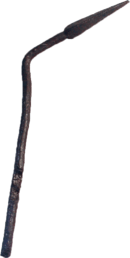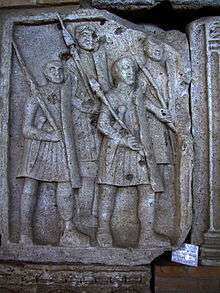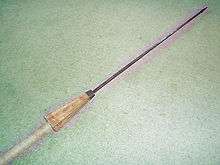Pilum
The pilum (plural pila; Classical Latin: [ˈpiːlũː]) was a javelin commonly used by the Roman army in ancient times. It was generally about 2 metres (6 ft 7 in) long overall, consisting of an iron shank about 7 millimetres (0.28 in) in diameter and 60 centimetres (24 in) long with a pyramidal head. The shank was joined to the wooden shaft by either a socket or a flat tang.

Design
The total weight of a pilum was between 2 and 5 pounds (0.9 and 2.3 kg), with the versions produced during the earlier Republic being slightly heavier than those produced in the later Empire.
The weapon had a hard pyramidal tip but the shank was sometimes made of softer iron. Some controversially believe that the softness would cause the shank to bend after impact and so render the weapon useless to the enemy. Others believe that the pilum was not meant to bend after impact but that bending came from improper handling/removal of the weapon when it was stuck in an object. Also, if the pilum struck a shield it might embed itself, the bending of the shank would force the enemy to discard his shield as unusable without removing the pilum, which would be time consuming. Even if the shank did not bend, the pyramidal tip still made it difficult to pull out. However, there were many cases in which the whole shank was hardened, making the pilum more suitable as a close quarters melee weapon and also made it usable by enemy soldiers.[1]
Although the bending of its shank is commonly seen to be an integral part of the weapon's design and as an intentional feature, there is little evidence to suggest that. The most commonly-found artifacts suggest that the pilum was constructed to use the weight of the weapon to cause damage, most likely to be able to impale through armour and reach the enemy soldier's body. The combination of the weapon's weight and the aforementioned pyramidal tip (the design of which would be seen in the Middle Ages in the form of bodkin arrow tips), allowed the pilum to be a formidable armour-piercing weapon. Because the weapon was meant to be used against armour and use its mass, as opposed to its speed, to cause damage, the bending of the shank seems to be a beneficial result of its intended use, which is to pierce through layers of armour. That the pilum needed to pierce layers of armour (through the shield, into body armour and past clothing) necessitated a lengthy shank, which was prone to bending. In one work, M.C. Bishop wrote that the momentum of the pilum caused the shank to bend upon impact, and although unintended, that proved to be a useful characteristic of the weapon.[2] However, a newer work by M. C. Bishop states that the pilum is "unlikely to bend under their own weight when thrown and striking a target or ground"; rather, it is human intervention such as improper removal of a pilum stuck in a target that is responsible in some way, and Caesar's writings should be interpreted as the pilum bending when soldiers tried to remove them.[3]
Since the pyramidal tip of a pilum was wider than the rest of the shank, once it penetrated a shield, it left behind a hole larger than the rest of the shank, and it could move through the shield with little resistance, stabbing the soldier behind. The length of the shank and its depth of penetration also made it difficult to pull out of a shield even if it failed to bend. If the bearer of the shield was charging and a pilum penetrated the shield, the end of the heavy shaft of the pilum would hit the ground, holding the shield in place. Some pila had a spike on the end of the shaft, which made it easier to dig into the ground.
Pila were divided into two models: heavy and light. Pictorial evidence suggests that some versions of the weapon were weighted by a lead ball to increase penetrative power, but archaeological specimens of that design variant are not so far known.[4] Recent experiments have shown pila to have a range of approximately 33 metres (100 ft), although the effective range is up to 15–20 m (50–70 ft). The earliest known examples of the heavy version of the pila have barbed heads and their tangs have a figure-eight shape.[5]
The pilum was also used as a melee weapon in close-quarters combat.[6] That includes pictorial depictions from the Tropaeum Traiani monument, descriptions of Caesar's troops using javelins as pikes against the Gauls in Caesar's Gallic War, Book VII and descriptions of Caesar's men using javelins to stab at Pompey's cavalry in Life of Caesar by Plutarch.
The angon was a similar weapon used in late Roman and post-Roman times.
The origin of the its design is a matter of contention. Arguments have been put forth which favour the design to be from ancient Italian tribes or from the Iberian Peninsula. Considering that there are two versions of the pilum (the heavy and the light), the Roman pilum may be descended two different weapons, perhaps from different cultural groups. The two weapon designs may have coalesced into the form of the typical Roman pilum, as it is known today.[7]
Tactics
Legionaries of the late republic and early empire often carried two pila, with one sometimes being lighter than the other. Standard tactics called for Roman soldiers to throw one of them (both if time permitted) at the enemy, just before charging to engage with the gladius; however, Alexander Zhmodikov has argued that the Roman infantry could use pila at any stage in the fighting.[8]
The effect of the pila throw was to disrupt the enemy formation by attrition and by causing gaps to appear in its protective shield wall.[1]
Pila could also be used in hand-to-hand combat; one documented instance of this occurred at the Siege of Alesia, and another during Mark Antony's Parthian campaign.[9] Additionally, pila could be employed as a thrusting implement and a barrier against cavalry charges.[10] Some pila had small hand-guards, to protect the wielder if he intended to use it as a melee weapon, but it does not appear that this was common.
Vegetius' commentary

The Roman writer Vegetius, in his work De Re Militari, wrote:
As to the missile weapons of the infantry, they were javelins headed with a triangular sharp iron, eleven inches [279 mm] or a foot long, and were called piles. When once fixed in the shield it was impossible to draw them out, and when thrown with force and skill, they penetrated the cuirass without difficulty.[11]
And later in the same work:
They had likewise two other javelins, the largest of which was composed of a staff five feet and a half long and a triangular head of iron nine inches [230 mm] long. This was formerly called the pilum, but now it is known by the name of spiculum. The soldiers were particularly exercised in the use of this weapon, because when thrown with force and skill it often penetrated the shields of the foot and the cuirasses of the horse.[12]
It may be argued that a short iron shaft has very few confirmations from archaeology. Vegetius wrote about a one-foot iron shaft because at Vegetius' time the pilum had disappeared and been replaced by similar shorter weapons such as the plumbatae and the spiculum.
Results of experimental archaeology

Thanks in part to experimental archaeology, it is generally believed that the pilum' had its design evolve to be armour-piercing: the pyramidal head would punch a small hole through an enemy shield allowing the thin shank to pass through and penetrate far enough to wound the man behind it. The thick wooden shaft provided the weight behind the punch.
In one description, one of the two iron nails that held the iron shaft in place was replaced with a weak wooden pin that would break on impact causing the shaft to twist sideways. Gaius Marius is sometimes given credit for that modification.[13]
Gallery
 Reconstruction of a post-Marian pilum
Reconstruction of a post-Marian pilum- A Roman coin showing an antoninianus of Carinus holding pilum and globe
 Close-up of re-enactment pila
Close-up of re-enactment pila
Notes
- Cowan, Ross (2003). "Equipment". Roman legionary: 58 BC - AD 69. Osprey Publishing. pp. 25–26. ISBN 978-1-84176-600-3. Retrieved 8 February 2012.
- Bishop, M.C.; Coulston, J.C.N. (2009). Roman Military Equipment from the Punic Wars to the Fall of Rome (2nd ed.). Oxford, UK: Oxford Books. pp. 50–51. ISBN 9781842171592.
- Bishop, M.C. (2017). The Pilum: The Roman Heavy Javelin. Osprey Publishing. ISBN 1472815882.
- Connolly, 1998, p233.
- Bishop, M.C.; Coulston, J.C.N. (2009). Roman Military Equipment from the Punic Wars to the Fall of Rome (2nd ed.). Oxford Books. p. 52. ISBN 9781842171592.
- Bishop, M.C. (2017). The Pilum: The Roman Heavy Javelin. Osprey Publishing. ISBN 1472815882.
- Bishop, M.C.; Coulston, J.C.N. (2009). Roman Military Equipment from the Punic Wars to the Fall of Rome (2nd ed.). Oxford, UK: Oxford Books. p. 52. ISBN 9781842171592.
- Zhmodikov, Alexander, 2000, "Roman Republican Heavy Infantrymen in Battle (IV-II Centuries B.C.)," in Historia: Zeitschrift für Alte Geschichte, vol. 49 no. 1.
- "tois yssois paiontes." Plutarch. "Life of Mark Antony, 45.3". Retrieved 2011-09-27.
- Arrian's Array against the Alans. "And the front four ranks of the formation must be of spearmen, whose spearpoints end in thin iron shanks. And the foremost of them should hold them at the ready, in order that when the enemies come near them, they can thrust the iron points of the spears at the breast of the horses in particular. Those standing in second, third and fourth rank of the formation must hold their spears ready for thrusting if possible, wounding the horses and killing the horsemen and put the rider out of action with the spear stuck in their heavy body armour and the iron point bent because of the softness. The following ranks should be of the javelineers."Dorst, Sander van. "Arrian's Array against the Alans". Retrieved 2010-10-03.
- Vegetius. "Book I". De Re Militari. Retrieved 2006-08-24.
- Vegetius. "Book II". De Re Militari. Retrieved 2006-08-24.
- Plutarch, "Gaius Marius", 25.2
References
Plutarch (2005). Penguin Classics: Fall of the Roman Republic. Translated by Rex Warner; Robin Seager. Penguin Classic; Revised edition. ISBN 978-0-14-044934-1.
- Connolly, Peter. Greece and Rome at War. Reprint: Greenhill Books, 1998 ISBN 1-85367-303-X.
- Connolly, Peter. "The pilum from Marius to Nero: a reconsideration of its development and function", Journal of Roman Military Equipment Studies, vol. 12/13, 2001/2, pp. 1–8.
External links
| Wikimedia Commons has media related to Pilums. |
- The Samnite Pilum
- The Pilum - The Roman Spear, Caerleon's Roman Legion
- Lance / Spear / Pilum / Catapult points, www.romanlegions.info
- Archaeological discovery of a pilum, Ecomuseum de Cap de Cavalleria.